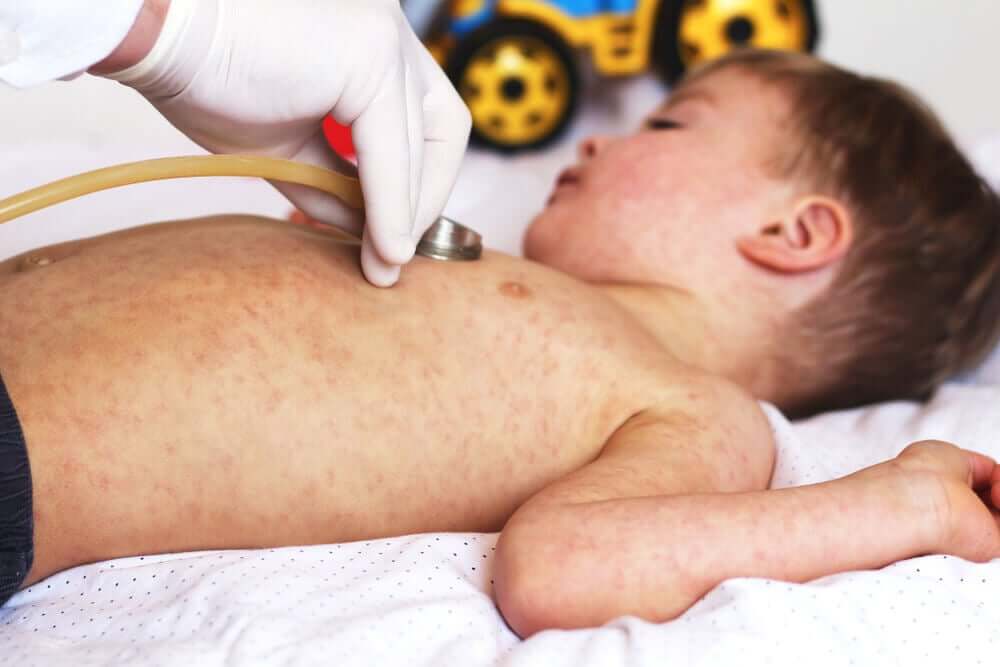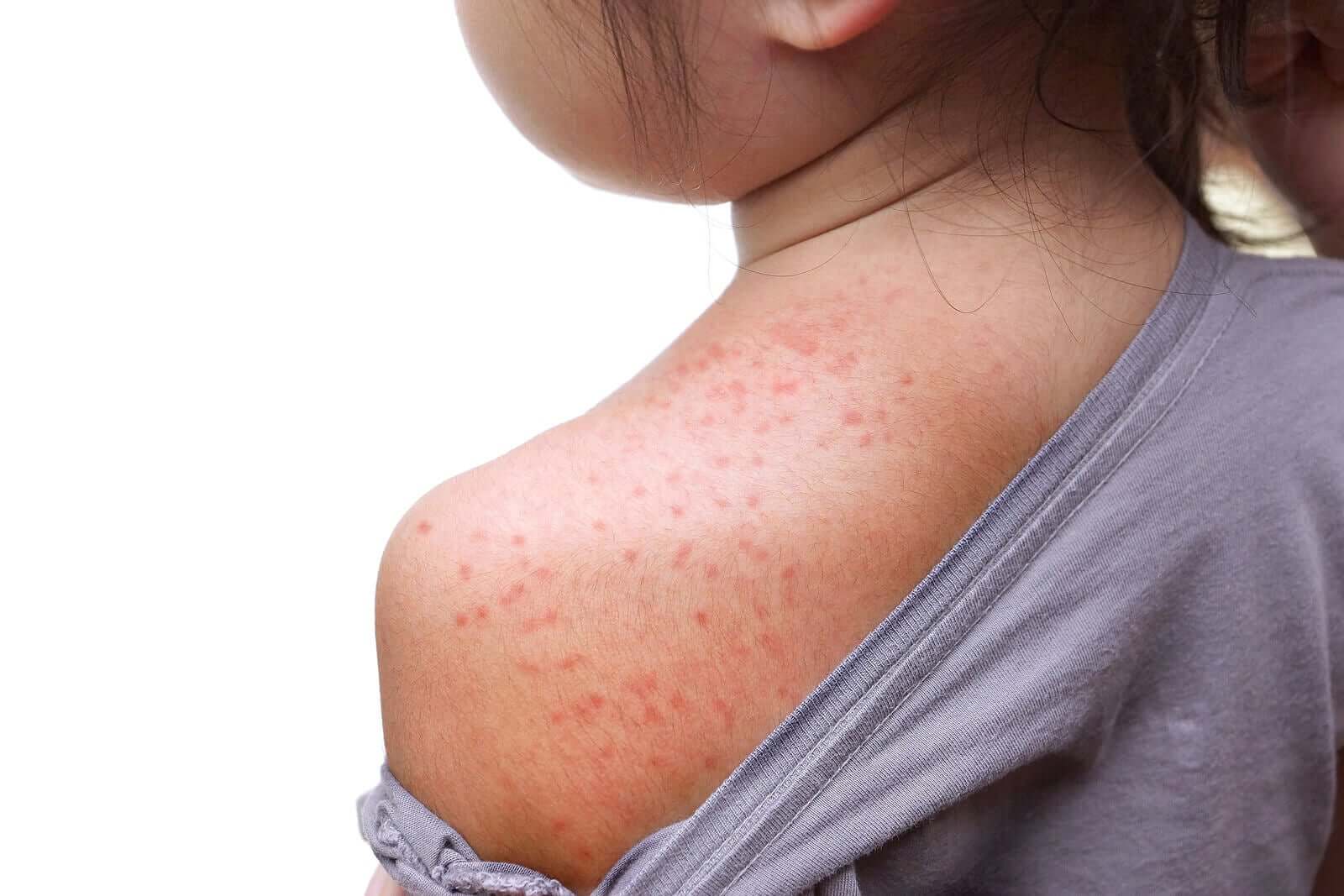Petechiae in Babies: Causes, Symptoms, and Treatment


Written and verified by the dermatologist Maria del Carmen Hernandez
Petechiae in babies are fairly common skin rashes, but they‘re one of the big red flags for parents and pediatricians. Do you want to know what they are? Then we’ll tell you everything you need to know.
What are petechiae?
Petechiae are tiny, very red lesions on the skin and mucosa. They look like small red dots that are less than 2 millimeters in diameter, which don’t disappear when you place pressure on them.
They result from the rupture of the small vessels of the skin and their consequent hemorrhage in the cutaneous dermis. However, they don’t cause bleeding to the outside.
Why do petechiae appear in babies?
As we mentioned earlier, petechiae are the sign of a lesion in the vessels of the dermis, called capillaries. These can break for multiple causes, but it’s important to determine what generates them, as in some contexts, they’re usually a warning sign of potentially serious diseases.
Regardless of the apparent reason, a baby with a fever and petechiae requires urgent evaluation.
In general, the diseases associated with petechiae vary according to the age of the child. Below, for practical purposes, we’ll list the most frequent causes according to the type of illness:
- Viral infections: Parvovirus B19, Dengue, Enterovirus
- Bacterial infections: Meningococcal infection, scarlet fever, infective endocarditis, Rocky Mountain spotted fever
- Congenital: Perinatal infections (toxoplasmosis, Rubella, Cytomegalovirus, and HIV)
- Yeast infections
- Traumatic: Injuries of an external cause, such as bumps, scrapes, or sustained efforts, such as a coughing attack
- Oncohematologic: Idiopathic thrombocytopenic purpura (ITP), Fanconi anemia, leukemia, thrombocytopenia-absent radius (TAR) syndrome, hemolytic uremic syndrome (HUS), and neonatal alloimmune thrombocytopenia (NAIT)
- Inflammatory and autoimmune: Henoch-Schonlein purpura (HSP) and systemic lupus erythematosus (SLE)
- Snake, spider, or other insect bites.
The main causes are hematological pathologies. However, invasive meningococcal disease is the most feared cause that must always be ruled out.

How are babies with petechiae evaluated?
When petechiae are found in the baby, a thorough physical examination and a complete history are necessary in order to arrive at the correct diagnosis.
It’s also important to consider the chronology of the case. In other words, the moment of appearance and how its evolution occurred until the moment of the consultation: If the lesions increased, if other symptoms were added, among other issues.
So, that being said, there are some signs and symptoms that can accompany petechiae and that represent red flags. Among them, the following stand out:
- Fever
- Increased blood pressure
- Palpitations or tachycardia
- Poor general condition or lethargy
- Paleness, dark circles under the eyes, or bruises on different parts of the body
- Bleeding in the skin or mucosa (gums, nose, or intestine)
- The rapid spread of petechiae
- Weightloss
- Swelling of the lymph nodes
In the case of the appearance of one or more of these signs, you need to make an urgent medical consultation.
It’s important to note that petechiae usually appear on the chest, face, arms, back, abdomen, buttocks, and feet. In addition, they’re lesions that don’t itch or hurt. This helps differentiate them from common allergies or stinging rashes.
Treatment options for petechiae in babies
The treatment to be implemented is related to the cause that produces these lesions and the general condition of the child.
- In the case of petechiae associated with trauma (blows, great efforts, or scrapes), the most appropriate behavior is to observe the evolution. In a typical scenario, petechiae resolve on their own within a few days.
- When it comes to severe infections such as bacterial infections, treatment requires the early initiation of intravenous antibiotics. For this reason, babies usually stay in the hospital for at least 48 hours, to monitor their progress. If, after this period, the condition doesn’t worsen and the laboratory studies are normal, the medical discharge is granted.
Differential diagnoses of petechiae

It’s important to know that petechiae are just one of the possible manifestations of skin bleeding. Other forms of skin bleeding include the following:
- Bruising
- Purples
- Ecchymosis
Therefore, the physician must differentiate between these types of bleeding and other similar-appearing lesions, which aren’t caused by lesions of the dermal vessels. Therefore, knowing the child’s vaccination status is a very important piece of information.
Read also: Exanthematous Diseases in Children
Petechiae in the baby and medical consultation
In conclusion, petechiae in the baby should be an alarm to consult a pediatrician, as there’s the possibility that they represent something serious.
Although they ultimately don’t require intervention to resolve, determining the cause of petechiae in young children is essential.
Petechiae in babies are fairly common skin rashes, but they‘re one of the big red flags for parents and pediatricians. Do you want to know what they are? Then we’ll tell you everything you need to know.
What are petechiae?
Petechiae are tiny, very red lesions on the skin and mucosa. They look like small red dots that are less than 2 millimeters in diameter, which don’t disappear when you place pressure on them.
They result from the rupture of the small vessels of the skin and their consequent hemorrhage in the cutaneous dermis. However, they don’t cause bleeding to the outside.
Why do petechiae appear in babies?
As we mentioned earlier, petechiae are the sign of a lesion in the vessels of the dermis, called capillaries. These can break for multiple causes, but it’s important to determine what generates them, as in some contexts, they’re usually a warning sign of potentially serious diseases.
Regardless of the apparent reason, a baby with a fever and petechiae requires urgent evaluation.
In general, the diseases associated with petechiae vary according to the age of the child. Below, for practical purposes, we’ll list the most frequent causes according to the type of illness:
- Viral infections: Parvovirus B19, Dengue, Enterovirus
- Bacterial infections: Meningococcal infection, scarlet fever, infective endocarditis, Rocky Mountain spotted fever
- Congenital: Perinatal infections (toxoplasmosis, Rubella, Cytomegalovirus, and HIV)
- Yeast infections
- Traumatic: Injuries of an external cause, such as bumps, scrapes, or sustained efforts, such as a coughing attack
- Oncohematologic: Idiopathic thrombocytopenic purpura (ITP), Fanconi anemia, leukemia, thrombocytopenia-absent radius (TAR) syndrome, hemolytic uremic syndrome (HUS), and neonatal alloimmune thrombocytopenia (NAIT)
- Inflammatory and autoimmune: Henoch-Schonlein purpura (HSP) and systemic lupus erythematosus (SLE)
- Snake, spider, or other insect bites.
The main causes are hematological pathologies. However, invasive meningococcal disease is the most feared cause that must always be ruled out.

How are babies with petechiae evaluated?
When petechiae are found in the baby, a thorough physical examination and a complete history are necessary in order to arrive at the correct diagnosis.
It’s also important to consider the chronology of the case. In other words, the moment of appearance and how its evolution occurred until the moment of the consultation: If the lesions increased, if other symptoms were added, among other issues.
So, that being said, there are some signs and symptoms that can accompany petechiae and that represent red flags. Among them, the following stand out:
- Fever
- Increased blood pressure
- Palpitations or tachycardia
- Poor general condition or lethargy
- Paleness, dark circles under the eyes, or bruises on different parts of the body
- Bleeding in the skin or mucosa (gums, nose, or intestine)
- The rapid spread of petechiae
- Weightloss
- Swelling of the lymph nodes
In the case of the appearance of one or more of these signs, you need to make an urgent medical consultation.
It’s important to note that petechiae usually appear on the chest, face, arms, back, abdomen, buttocks, and feet. In addition, they’re lesions that don’t itch or hurt. This helps differentiate them from common allergies or stinging rashes.
Treatment options for petechiae in babies
The treatment to be implemented is related to the cause that produces these lesions and the general condition of the child.
- In the case of petechiae associated with trauma (blows, great efforts, or scrapes), the most appropriate behavior is to observe the evolution. In a typical scenario, petechiae resolve on their own within a few days.
- When it comes to severe infections such as bacterial infections, treatment requires the early initiation of intravenous antibiotics. For this reason, babies usually stay in the hospital for at least 48 hours, to monitor their progress. If, after this period, the condition doesn’t worsen and the laboratory studies are normal, the medical discharge is granted.
Differential diagnoses of petechiae

It’s important to know that petechiae are just one of the possible manifestations of skin bleeding. Other forms of skin bleeding include the following:
- Bruising
- Purples
- Ecchymosis
Therefore, the physician must differentiate between these types of bleeding and other similar-appearing lesions, which aren’t caused by lesions of the dermal vessels. Therefore, knowing the child’s vaccination status is a very important piece of information.
Read also: Exanthematous Diseases in Children
Petechiae in the baby and medical consultation
In conclusion, petechiae in the baby should be an alarm to consult a pediatrician, as there’s the possibility that they represent something serious.
Although they ultimately don’t require intervention to resolve, determining the cause of petechiae in young children is essential.
All cited sources were thoroughly reviewed by our team to ensure their quality, reliability, currency, and validity. The bibliography of this article was considered reliable and of academic or scientific accuracy.
- Asociación Española de Pediatría. Infección meningocócica. [Internet] Disponible en: https://www.aeped.es/sites/default/files/documentos/meningococo.pdf
- Edmonson MB, Riedesel EL, Williams GP, Demuri GP. Generalized petechial rashes in children during a parvovirus B19 outbreak. Pediatrics. 2010 Apr;125(4):e787-92. doi: 10.1542/peds.2009-1488. Epub 2010 Mar 1. PMID: 20194277.
- Brogan PA, Raffles A. The management of fever and petechiae: making sense of rash decisions. Arch Dis Child. 2000 Dec;83(6):506-7. doi: 10.1136/adc.83.6.506. PMID: 11087287; PMCID: PMC1718572.
- Lee MH, Barnett PL. Petechiae/purpura in well-appearing infants. Pediatr Emerg Care. 2012 Jun;28(6):503-5. doi: 10.1097/PEC.0b013e3182586f5f. PMID: 22653463.
This text is provided for informational purposes only and does not replace consultation with a professional. If in doubt, consult your specialist.








